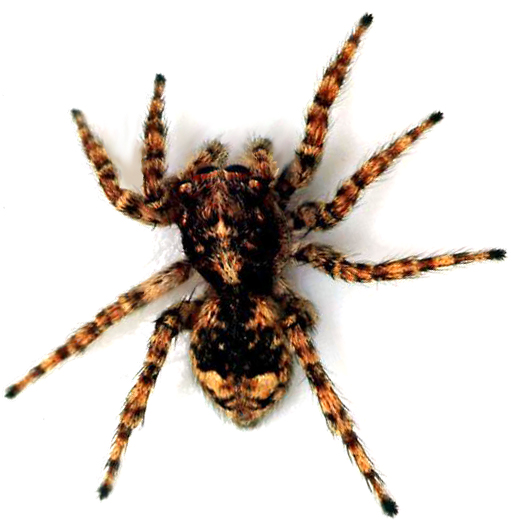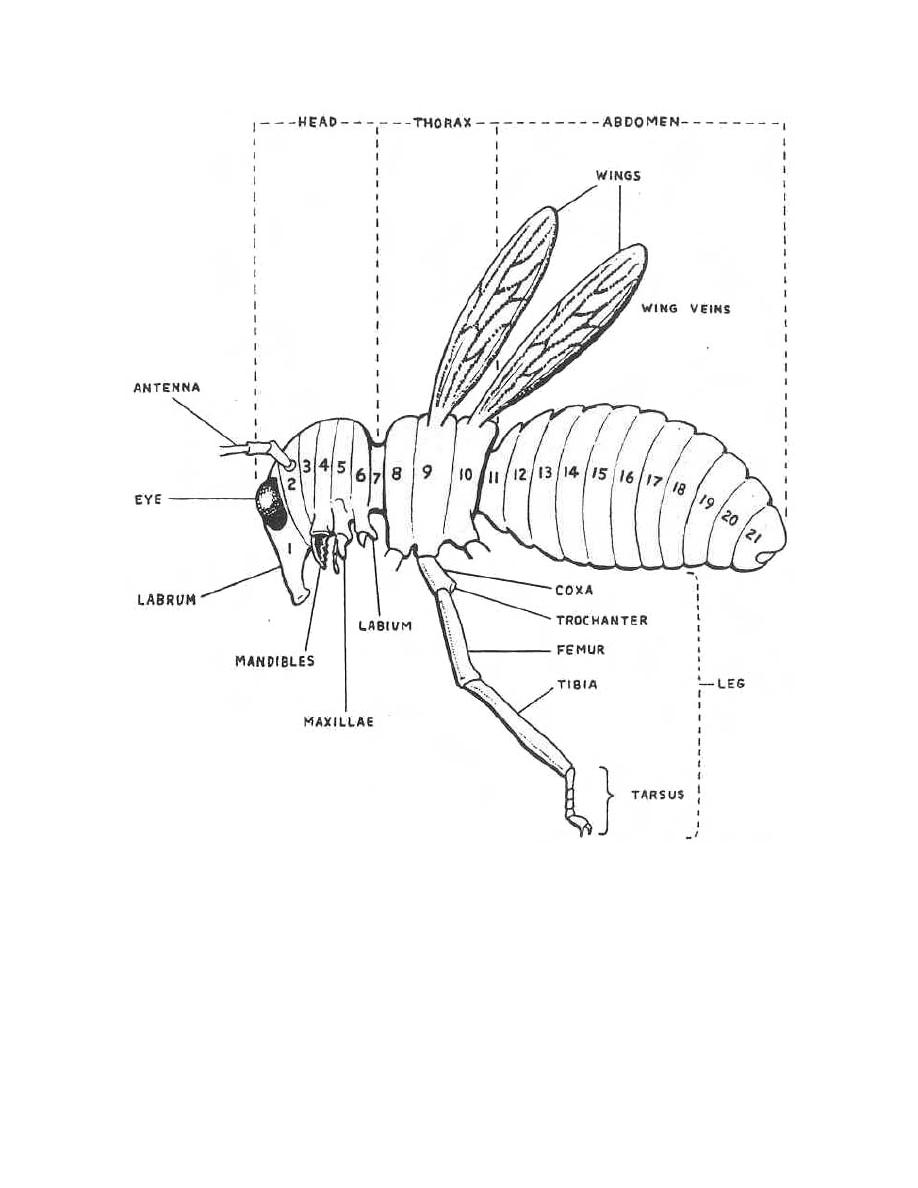 By: Chloe, Quincey, Kaile
By: Chloe, Quincey, Kaile
Vertebrate or Invertebrate?
Arthropods are invertebrates, as well as echinoderms. An invertebrate is an animal without a backbone. Most animals are not invertebrates. A vertebrate is an animal with a backbone.

http://arachnofriends.wordpress.com/2008/04/18/jumping-spiders/
This is an example of an invertebrate.
Definition: Arthropod
An arthropod is an animal with a segmented body jointed limbs and occasionally arthropods have a chitinous shell that undergoes molding. An chitinous shell is a part of the exoskeleton in the animal. An echinoderm is a the same as an arthropod. Arthropods and echinoderms are unique because they are over one million species, they are bilateral symmetrical, and they have jointed legs like a human does. Being an invertebrate can be an advantage or disadvantage. It can be an advantage because you can be more flexible. But, it can be a disadvantage because it can mean you have an exoskeleton and that can make you less flexible.
Definition: Echinoderm
Echinoderms is short for phylum echinodermata. Phylum Echinodermata means phylum of marine animal. Echinoderms can be found at ocean depth. The term echinoderm came from the Greeks and means spiny skin. The first Echinoderms appeared during the Cambrian Period. Echinoderms are important geologically and biologically. Their important geologically because their bony skeleton can provide valuable clues to limestone information, and to the geological environment. It is important biologically because few other groupings are so abundant in deep seas, or shallow oceans. Lastly, the radiation of echinoderms was responsible for the Mesozoic revolution of marine life.

http://www.tpub.com/content/armymedical/MD0842/MD08420220.htm
Types of Arthropods
Different types of arthropods include scorpion, butterfly, lobster, ladybug, and a starfish. These animals and insects are arthropods because they have a segmented body which include: a head, thorax and abdomen. They also have jointed appendages, an exoskeleton (a skeleton outside of their skin), eyes, mouth, antennae, abdomen-innards, genitalia. All of these animals are an invertebrate. These animals also have an internal cavity called an hemocoel. The internal cavity helps the animals internal organs adapt to what comes into them. Arthropods also have an open circulatory system which means that their nervous system is like a latter

http://www.junglewalk.com/photos/echinoderm-pictures.htm

http://animals.nationalgeographic.com/bugs/ladybug/

http://www.google.com/imgres?imgurl=http://www.flatrock.org.nz/topics/animals/assets/scorpion.jpg&imgrefurl=http://www.flatrock.org.nz/topics/animals/scorpions_are_major_cause_of_death.htm&h=480&w=414&sz=29&tbnid=zFApOoRsTMEsxM:&tbnh=242&tbnw=208&prev=/images%3Fq%3Dpictures%2Bof%2Bscorpions&zoom=1&q=pictures+of+scorpions&usg=__rYTDMwv_jAPl5e9V5-7TNblKaWE=&sa=X&ei=iKp2Tc2uDI60sAOZ0Py6BA&ved=0CCwQ9QEwAg

http://animals.nationalgeographic.com/animals/invertebrates/lobster/
Evolution of Arthropods
Arthropods initially arrived on Earth during the Cambrian Period. Arthropods are characterized by possessive joint limbs and having an exoskeleton. Because Arthropods belong to the protosomia as well as annelid worms, scientists believe Arthropods evolved from Annelids or shared a common ancestor with them.

http://www.google.com/imgres?imgurl=http://www.biomedcentral.com/content/figures/1471-2148-7-118-2-l.jpg&imgrefurl=http://www.biomedcentral.com/1471-2148/7/118/figure/F2%3Fhighres%3Dy&h=1742&w=1200&sz=150&tbnid=YOxU97OjqegvUM:&tbnh=271&tbnw=186&prev=/images%3Fq%3Dphotos%2Bof%2Bevolution%2Bof%2Barthropods&zoom=1&q=photos+of+evolution+of+arthropods&hl=en&usg=__sx74VqinKppkUOlEzKS5Dbw2owg=&sa=X&ei=YoN-Tf2_OofwrAGO6ZWDBg&ved=0CBsQ9QEwAQ
Evolution of Echinoderms
Echinoderms are the most distinctive of all animal phyla. They first appeared on fossil record during the pre-cambrian period. Phylogenetic poition of the Concentricycloidea remains controversal.

http://www.google.com/imgres?imgurl=http://www.answersingenesis.org/assets/images/articles/ee/v2/echinoderm-tree.jpg&imgrefurl=http://www.answersingenesis.org/articles/ee/origin-of-invertebrates&usg=__k7L4Aov99couUOqaAsabg8tJsqw=&h=850&w=1280&sz=115&hl=en&start=0&sig2=ymNuYdQMxpBIrkM_3m6z3w&zoom=1&tbnid=iUauLDl_lBKLBM:&tbnh=96&tbnw=145&ei=-DOATdHONJHQsAPWqdTqBQ&prev=/images%3Fq%3Devolution%2Bof%2Bechinoderms%26um%3D1%26hl%3Den%26sa%3DN%26biw%3D1096%26bih%3D684%26tbs%3Disch:1&um=1&itbs=1&iact=hc&vpx=103&vpy=90&dur=1431&hovh=183&hovw=276&tx=169&ty=102&oei=-DOATdHONJHQsAPWqdTqBQ&page=1&ndsp=24&ved=1t:429,r:0,s:0
Echinoderms
Echinoderms are characterized by radial symmetry and having several arms. Their body has five equal segments, each has a duplicate set of diverse internal organs. Echinoderms have no heart, brain, and no eyes. Their mouth is placed on the under side and their anus on top. Echinoderms are only marine and can survive in various habitats all the way from the intertidal zone to the bottom of the deep sea with trenches or coral reefs. Some Echinoderms, like starfish, are carnivorous while others are foragers or planktonic feeders. Echinoderms only live in salt water.
Types of Echinoderms
- Starfish
- Sea Urchin
- Sea cucmumber
- Sand Dollar
- There are about 6000 more species of echinoderms

http://www.google.com/imgres?imgurl=http://www.users.zetnet.co.uk/belhavia/images/flystara.gif&imgrefurl=http://www.users.zetnet.co.uk/belhavia/echin.htm&usg=__jvCRdPGY7lUtjvzw_kRCROK5NGQ=&h=373&w=623&sz=14&hl=en&start=16&sig2=trjWlx0zppKgb0wjIKrIUA&zoom=1&tbnid=IsHh3x4A2NgExM:&tbnh=103&tbnw=172&ei=7qt9TfWbNIuosQPA49yTAw&prev=/images%3Fq%3Dechinoderms%26um%3D1%26hl%3Den%26sa%3DN%26biw%3D1128%26bih%3D611%26tbs%3Disch:10%2C564&um=1&itbs=1&iact=rc&dur=477&oei=c6t9TdaOOYf4sAOes6mMAw&page=2&ndsp=15&ved=1t:429,r:10,s:16&tx=126&ty=40&biw=1128&bih=611

http://www.google.com/imgres?
imgurl=http://www.tvcc.edu/depts/Biology/HotPot/Images/Biol%25201407/echinoderms.jpg&imgrefurl=http://www.tvcc.edu/depts/biology/Hotpot/Biol%25201407/animal_phyla.htm&usg=__XxYW_F7LALVWNcSoEBzGOFXhKjA=&h=370&w=320&sz=93&hl=en&start=0&sig2=t0UxBZrKwH6B0yGPrBmBvg&zoom=1&tbnid=KRYfUa9cemvicM:&tbnh=137&tbnw=107&ei=VKt9TYeTMIyksQO4o7WSAw&prev=/images%3Fq%3Dechinoderms%26um%3D1%26hl%3Den%26sa%3DN%26biw%3D1128%26bih%3D611%26tbs%3Disch:1&um=1&itbs=1&iact=hc&vpx=297&vpy=249&dur=568&hovh=241&hovw=209&tx=97&ty=158&oei=VKt9TYeTMIyksQO4o7WSAw&page=1&ndsp=16&ved=1t:429,r:6,s:0

http://www.google.com/imgres?imgurl=http://laughingmantis.com/wp-content/uploads/2010/06/EchinodermCladogramPoster_small.jpg&imgrefurl=http://laughingmantis.com/2010/06/echinodermata/&usg=__EBuEhU8tzV0Chd2OgeJAvzlVE9Y=&h=706&w=1024&sz=538&hl=en&start=108&sig2=OIAKfcYfkUWU06UCuCXGuQ&zoom=1&tbnid=C1VgVA-25eCAVM:&tbnh=136&tbnw=183&ei=gax9Ta_gL47WtQOf3pWVAw&prev=/images%3Fq%3Dechinoderms%26um%3D1%26hl%3Den%26sa%3DN%26biw%3D1128%26bih%3D611%26tbs%3Disch:10%2C3343&um=1&itbs=1&iact=hc&vpx=257&vpy=312&dur=335&hovh=182&hovw=264&tx=177&ty=82&oei=TKx9TfaMLIegsQPhntSKAw&page=8&ndsp=15&ved=1t:429,r:6,s:108&biw=1128&bih=611
More About Echinoderms
An Echinoderms nervous system has eyespots that can detect light. Their eyespots aren't as sharp as human eyes and have a poor nervous system in general. An echinoderm has water pumped through it. This process is part of the circulatory system. In reproduction, females and males discharge their eggs and sperm into the water where they fertalize. Females can release up to one humdred million eggs at once. If something is chopped off of an echinoderm and can regrow.
.gif) http://www.mcwdn.org/Animals/Starfish.html
http://www.mcwdn.org/Animals/Starfish.html
Fun Facts About Arthropods!
1. Arthropods evolved 445 million years ago and are divided into the cephalothorax and opisthosoma also known as chelicerate bodies. Crustaceans include 5,000 species and mainly live in marine or fresh water environments. Hexapods are the group of arthropods that include insects. The body of a hexapod has three sections, a head, thorax, and abdomen. Myriapods have 13,000 species of millipedes and centipedes. They live in forest habitats and have long bodies with many pairs of legs.
2. Ancestral arthropods were the first land animals. The oldest animal to live on land is the arthropod Pneumodesmus newmani. Fossils were discovered in Scotland, 2004. It is known as a millipede and has lived for 428 million years ago during the silurian period.
3.Arthropods have an open circulatory system. Arthropods have an internal cavity called a hemocoe. This makes its so the arthropod is bathed in fluids. This is way enables the exchange of the nutrients, waste material, and gasses the body could get.
4. Most arthropods will lay eggs, but the scorpion is the only exception. They will lay their eggs internally and give birth to the children.
Questions
- Are arthropods bilateral symmetrical?
- Do arthropods have jointed legs?
- Are arthropods vertebrates or invertebrates?
- True or False? There is over 1 million species of arthropods?
- Do arthropods have a segmented body?
- True or False? Arthropods have no exoskeleton.
- Do arthropods have a chitinous shell?
- True or False? All arthropods have antennaes.
VIDEOS
http://naturebytesvideo.com/bytes_P-R/phylum_arthropoda.html
http://www.arkive.org/mexican-redknee-tarantula/brachypelma-smithi/video-03.html
http://www.ehow.com/video_2298765_corn-snake-skin-shedding.html
Bibliography
http://wiki.answers.com/Q/Are_some_arthropods_vertebrates
http://en.wikipedia.org/wiki/Arthropod
http://en.wikipedia.org/wiki/Echinoderm
http://www.mcwdn.org/Animals/Starfish.html
http://www.biology-online.org/10/6_arthropods.htm
http://www.historyoftheuniverse.com/arthropo.html
http://tolweb.org/Echinodermata
Comments (0)
You don't have permission to comment on this page.